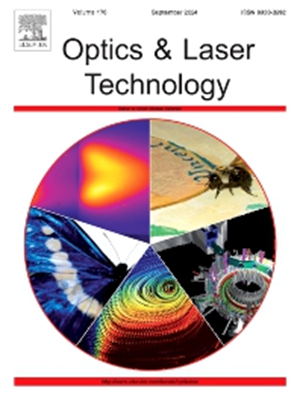Microstructure and mechanical properties of additive manufactured TiC-reinforced Fe55Cr25Co10Ni10 high-entropy alloy composites
IF 4.6
2区 物理与天体物理
Q1 OPTICS
引用次数: 0
Abstract
The FeCrCoNi series of high-entropy alloys have received widespread attention due to their excellent properties at room and low temperatures, however, the relatively low yield strengths severely limit their wide application. Currently, the research efforts in the field of ceramic particles strengthening mainly focus on the equiatomic high-entropy alloy systems. However, there have been few studies on high-entropy alloys with non-equiatomic ratios. This paper provides a detailed investigation into the mechanism of the effect of 5 wt% TiC ceramic particles on the microstructure, mechanical properties and friction and wear properties of Fe55Cr25Co10Ni10 high-entropy alloys. The results indicated that the alloy’s phase structure of the alloy changes significantly after addition 5 wt% TiC ceramic particles. The alloy transitions from the original single FCC solid solution to a composite structure consisting of FCC solid solution and TiC particles. At the same time, the alloy’s microstructure is transformed from a single columnar crystal structure to a composite structure, which includes columnar dendrites, cellular dendrites and unmelted TiC particles. Notably, this transformation has significantly improved mechanical properties: the yield strength increased from 203 MPa to 254 MPa (improved 25.1 percent), and the tensile strength increased from 542 MPa to 635 MPa (improved 17.2 percent). Theoretical calculations and practical test analyses reveal that addition TiC ceramic particles leads to a significant increase in yield strength, which is mainly attributed to the combined contribution of the Hall-Petch strengthening effect, the dislocation strengthening mechanism and the Orowan strengthening effect. In addition, it is demonstrated that high-entropy alloy composites’ friction and wear performance at room temperature exhibits excellent characteristics compared to high-entropy alloy materials. It is expected to be widely applied in the manufacturing of components in key areas of the aerospace field.
求助全文
约1分钟内获得全文
求助全文
来源期刊
CiteScore
8.50
自引率
10.00%
发文量
1060
审稿时长
3.4 months
期刊介绍:
Optics & Laser Technology aims to provide a vehicle for the publication of a broad range of high quality research and review papers in those fields of scientific and engineering research appertaining to the development and application of the technology of optics and lasers. Papers describing original work in these areas are submitted to rigorous refereeing prior to acceptance for publication.
The scope of Optics & Laser Technology encompasses, but is not restricted to, the following areas:
•development in all types of lasers
•developments in optoelectronic devices and photonics
•developments in new photonics and optical concepts
•developments in conventional optics, optical instruments and components
•techniques of optical metrology, including interferometry and optical fibre sensors
•LIDAR and other non-contact optical measurement techniques, including optical methods in heat and fluid flow
•applications of lasers to materials processing, optical NDT display (including holography) and optical communication
•research and development in the field of laser safety including studies of hazards resulting from the applications of lasers (laser safety, hazards of laser fume)
•developments in optical computing and optical information processing
•developments in new optical materials
•developments in new optical characterization methods and techniques
•developments in quantum optics
•developments in light assisted micro and nanofabrication methods and techniques
•developments in nanophotonics and biophotonics
•developments in imaging processing and systems

 求助内容:
求助内容: 应助结果提醒方式:
应助结果提醒方式:


